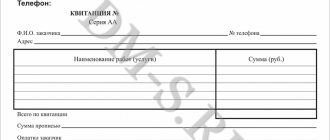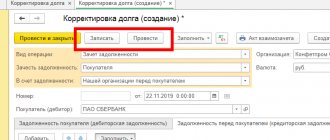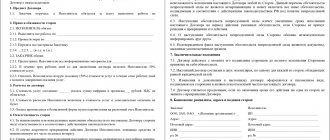How to arrange mutual settlement between organizations? What are the requirements for mutual settlement? In what cases is mutual offset unacceptable? With the help of what document is the offset made? How are offset transactions reflected in accounting? — answers to all the questions listed in the Firmmaker article.
In the 90s, more than half of all payments in Russia were carried out in non-monetary form. At that time, due to a lack of working capital, bills of exchange and barter were actively used in mutual settlements between enterprises. On the one hand, the use of bills and barter led to a decrease in the need for credit resources and other funds, but on the other hand, this only aggravated the problem of non-payments. The contradictions that arose led to the fact that organizations gradually abandoned the use of bills and barter in mutual settlements. Today, if an enterprise does not have sufficient available funds to settle payments with counterparties, the operation of offsetting mutual claims is used.
Concept and essence
From a legal point of view, offsets and mutual settlements are a civil law transaction, that is, actions of subjects of civil law relations aimed at the emergence, change or termination of civil rights and obligations (Article 153 of the Civil Code of the Russian Federation). Accordingly, mutual settlement is a transaction aimed at terminating civil rights and obligations.
Mutual settlement as a type of civil transaction is not directly regulated by the Civil Code of the Russian Federation. The specified regulatory document, as one of the ways to terminate obligations, indicates only the possibility of compensation of mutual claims (Article 410 of the Civil Code of the Russian Federation) between two persons. However, by virtue of paragraph 2 of Art. 421 of the Civil Code of the Russian Federation, which enshrines the principle of freedom of contract, clearing operations with a large number of participants are quite acceptable, since these operations do not contradict the essence of civil relations.
The legal basis for mutual settlements is determined by the rules of civil law on compensation of mutual claims. At the same time, in some cases, for mutual settlement it is necessary to carry out other operations, in particular, the transfer of the right of claim (Article 382 of the Civil Code of the Russian Federation).
Mutual settlement is an agreement between the parties to civil law relations on the mutual termination of certain obligations in a fixed amount in relation to each other.
The important point is that:
- obligations bear homogeneity;
- a deadline was set for meeting time commitments.
Settlement cannot be performed if:
- the obligation of either party is related to compensation for damage caused to health, payment of alimony;
- for the obligations of either party, the statute of limitations has expired;
- concluding a mutual settlement agreement is expressly prohibited by law or contract.
In business activities, organizations interact with each other as counterparties, suppliers and buyers. The most important part of working with counterparties is accounting. Mutual settlements show where part of the organization’s financial resources are located and the main sources of these funds. Thus, the amount of money that can be directed into the further turnover of the company depends on timely monitoring of mutual settlements.
Mutual settlements are carried out in the context of counterparties and settlement documentation in the context of concluded contracts.
The calculation is made on the basis of accounting according to primary documents.
Accounting for settlements allows you to determine the total amount of debt for any period of time, as well as understand when and on what documents it appeared.
Is cash payment possible?
Organizations have the right to pay each other in cash and non-cash methods. When paying in cash, you must issue a receipt order.
It must be remembered that the legislation of the Russian Federation provides for restrictions on cash payments between organizations. Today this amount is 100,000 rubles.
If the amount of debt to be liquidated through mutual settlement exceeds this figure, then settlement should be made in cash within this limit, and the remaining amount should be transferred to a bank account.
Unilateral offset is a settlement between two legal entities at the request of one of the parties.
To carry out this operation, one of the organizations sends a written application for offset, as well as an act. Moreover, if the other party agrees with the act and accepts it, the operation is considered carried out on the day the act is signed by the other counterparty.
Requirements for organizing a settlement system
When working with regular clients, as a rule, mutual settlements are carried out in accordance with a scheme developed through negotiations between the parties. This system is convenient for all participants.
There are some requirements in this area that must be strictly followed.
Requirements for the system of mutual settlements between enterprises:
- truthfulness;
- the output of data on mutual settlements should be quick and easy;
- ability to manage debt;
- detailed reports of any complexity.
This system includes two subsystems: the first characterizes the movement of goods (warehouse), the second characterizes the movement of money (cash finance). Both of these subsystems are inseparable from each other and participate in mutual settlements.
Which calculations are not subject to the limit rule?
There are business transactions that cannot be carried out through bank accounts, so the central bank has established some rules that allow you to increase the amount of cash, bypassing the rules for settlement limits between business entities. This may be in the following cases, which are set for 2019:
- when wages are paid to employees of a legal entity or individual entrepreneur;
- in the case of making various payments and charges that are of a social nature, which may include payment for hospital and other expenses;
- when a legal entity issues funds under a special report, for example in the form of travel allowances;
- There is a separate column for individual entrepreneurs, since the limit does not apply to the expenditure of funds that will be spent on the personal needs of a businessman, under one condition, if this payment is not used to carry out his commercial activities.
You need to understand that all the risks associated with violating the rules on the limit are borne not only by various enterprises, but by businessmen who are individual entrepreneurs. If we analyze the imposition of penalties for limit violations, we can see that entrepreneurs also paid a large amount of money in the form of fines.
This rule has been retained for 2021.
Types of mutual settlements
Mutual settlements can be divided into several types, of which the three largest are:
- payments for orders: in the case when payment is made for a specific customer order;
- Contract settlement: All purchases and sales are carried out in accordance with the contract signed between the parties. This may be the sale of goods on credit or purchase with prepayment;
- invoice payments: in this case, the purchase or sale is paid separately for specific invoices.
Thus, mutual settlements represent a direct redistribution of income from the sale of goods or services between organizations that provide services or sell goods.
Simply put, it is the buying and selling of goods. In most cases, an accountant-economist conducts all settlement operations; he is also responsible for all reporting documentation for mutual settlements.
To control quality in modern conditions, it is simply necessary to use high-quality software.
As a rule, a competent reflection of current transactions allows the company to quickly and timely obtain any information about the state of mutual settlements between counterparties.
Accounting entries
In accounting, settlement of mutual obligations should be reflected in sub-accounts opened for each of the parties. In accounting, account 60 includes settlements with suppliers and contractors, and account 76 includes transactions with various debtors and creditors.
In most cases, offset is possible only if there are homogeneous claims. In this regard, the repayment of mutual debts between several legal entities does not fall under the concept of offset, since one organization has receivable obligations to another and creditor obligations to a third. However, in practice such operations are possible.
In case of multilateral netting, the parties draw up an agreement on mutual settlements. The form of this document is not regulated and can be arbitrary, but does not contradict the requirements for primary accounting documentation.
Drawing up an accounting entry becomes possible only after drawing up an act of mutual settlement. The debit column displays the item for which the payable obligation to the supplier or contractor appeared (account 60 or 76). In the credit column of an accounting document, as a rule, account 62 is indicated. For example, the entry debit 60 - credit 62 means that offset was carried out based on the agreement of the parties.
The accountant of the organization initiating the offset draws up the posting on the day the act is sent to the other party.
Basic documents
Among the settlement documents are:
- documents for the shipment of products (invoices, acceptance certificates, sales certificates, etc.);
- payment documents (payments, consumables, orders);
- documents – basis of transactions (agreements, specifications).
Based on the nature of the documentation, mutual settlement transactions can be divided into the following:
- simple - when only documents for shipment and payment are drawn up;
- transactions on invoices - documents on shipment and payment are drawn up on the basis of invoices;
- transactions under contracts - shipment and payment documents are drawn up under contracts.
Features of settlement under an assignment agreement
From a legal point of view, an assignment agreement provides for a legal transaction related to the fact that the debt of a legal or individual person, as well as an individual entrepreneur (debtor), is transferred by one business entity (creditor) to another. There is nothing complicated in the legal procedure for transferring debt; it is enough to draw up a special agreement, but from a financial point of view, such legal relations are also subject to a limit. The procedure for transferring debt under an assignment agreement is as follows:
- between the old and new creditor, a special agreement is signed for the assignment of the right to claim the debt to the new creditor;
- after this, the debtor is notified in writing of the transfer of the debt, and from that moment the new creditor has a legal basis to claim the debt.
The debt itself can be expressed in monetary or material equivalent, but from an accounting point of view, any thing that acts as a debt must be converted into a monetary equivalent, that is, have a value. Based on this, we can say that the debt is necessarily subject to the settlement limit established by the Central Bank of Russia.
It follows from this that when the debtor decides to pay off a debt that exceeds the amount of 100,000 rubles, then the money must necessarily go through the current account or cash register of an individual entrepreneur and a legal entity. If, on the contrary, the amount of the debt is less than the above amount, then it can be paid in cash, with its mandatory capitalization.
It is important to know that if the debt is paid by an individual, there are no restrictions, and any amount can be transferred in cash to the cash desk of an enterprise or individual entrepreneur. Such agreements are typical for various loan agreements, in which ordinary citizens act as debtors, and collection companies become creditors.
These rules for debt payment also remained in 2019.
Settlement agreement
A settlement agreement between organizations implies the repayment of debts of several companies to each other.
This situation is possible if both enterprises act under the same or different agreements with customers and suppliers at the same time. The procedure can be initiated when there is a debt for goods provided or services provided by both parties that cannot be repaid in the near future.
The offset can be made in full of the debt or only part of the amount of overdue payment under the contract. Civil law imposes such requirements on the debts of enterprises, which are planned to be compensated through offset.
The basic requirements for settlements under a mutual settlement agreement between organizations are as follows:
- mutual settlement implies that both parties have financial claims against each other due to delays in payments under existing contracts;
- an agreement on mutual settlement between organizations is possible if the obligations are homogeneous - they have the same indicators (if this is a cash equivalent, then the currency of settlement must match);
- deadlines for fulfilling contractual obligations regarding payment for goods, work or src=»https://FB.ru/misc/i/gallery/5158/2950747.jpg» class=»aligncenter» width=»788″ height=»793″ have been accepted [/img]
The settlement agreement cannot be applied if:
- the debt was formed in accordance with the amount of compensation for harm caused to the health of an individual or his life;
- debts were formed under writs of execution for the collection of alimony;
- the statute of limitations has expired (Article 411 of the Civil Code of the Russian Federation).
A standard agreement on mutual settlement between legal entities implies an indication of the exact amounts of debt of both parties to the agreement, with the allocation of VAT. To do this, at the stage of preparing the contract form, mutual reconciliation of calculations is performed. The agreed act of reconciliation is attached to the contract along with documentation substantiating the fact of overdue debt.
A settlement agreement between organizations (a sample can be seen below) requires the following details:
- date and place of conclusion of the contract;
- names of the parties;
- names of company representatives with supporting documents of authority;
- a list of financial obligations that need to be repaid;
- indication of the terms of mutual settlements.
At the end, a phrase is necessary that when the date of entry into force of the provisions of the agreement arrives, the details of the parties and their addresses must be indicated. At the end of the document there must be signatures of authorized persons and company seals.
We will consider the mutual settlement agreement between an organization and an individual and its features below. With this type of settlement, one party is the creditor, the other is the debtor. The features of this type of calculation are as follows:
- homogeneous nature of the requirements (financial);
- clearly established deadlines;
- the possibility of settlements not for the entire volume of debts at once, but in parts;
- possible if there are at least two obligations between the parties (debt and payment).
Nuances of drawing up an agreement between organizations
The execution of the agreement, as well as its content, is completely left to the employees of the companies. It can be written on an ordinary sheet of paper of any convenient format or on the letterhead of any organization, by hand or in printed form. Next, the document is signed by the directors or their representatives on both sides. Signatures must be “natural”.
If organizations use seals and stamps in their activities, then the agreement form should be endorsed.
The agreement is made in two identical and equivalent copies - one for each of the interested parties. After the document is completed and endorsed, it must be registered in the document register of each company. In the future, the document serves as the basis for carrying out relevant accounting operations.
The agreement should be stored together with the contract in a separate folder for the period established by the legislation of the Russian Federation or internal regulations of companies (but not less than three years).
Characteristics of Sberbank bills
Let's take a closer look at what a Sberbank bill of exchange is for mutual settlements between organizations. Any bill of exchange, regardless of the purpose of its creation and the person who issued it, is primarily a valuable document. It acts as a significant fulfillment of an obligation, for which the debtor pays a certain amount of money to the creditor after a certain period of time.
The bill of exchange is used for mutual settlements between individuals and between organizations, including between financial institutions. Sberbank also belongs to them. Such bills act as a universal payment method. The bank issues them for quick payments for the supply, sale of goods or provision of services. In addition, the account can be used as collateral when obtaining a loan product from the bank. But the Sberbank bill of exchange is most often used for settlements between organizations.
Sberbank's bill of exchange for mutual settlements between organizations contains security that confirms the bank's obligation to the holder to pay a certain amount for a certain period. The bill of exchange is required for settlements; its registration can be carried out at any branch of Sberbank.
A bill of exchange is an A4 format document. It includes the amount that the client deposited. In addition, the city and date of issue are indicated.
A bank promissory note is a security that contains a written promissory note of a banking organization to the holder of the bill.
This tool provides the following benefits:
- convenient and fast payment for services, works and goods;
- profitable investments for profit;
- use as a guarantor when receiving credit funds or guarantees from a bank.
Promissory note programs provided by banks are similar to depository programs: the client invests funds, and in return receives something from the banking institution, similar to a promissory note. Thus, the bank confirms that the funds are accepted and undertakes to return them on the appointed day.
An interest-bearing bill means an indication of the interest that is charged on its amount. Nominal interest amounts can be expressed both in rubles and in other currencies. To obtain such a promissory note, you must deposit money, which is a nominal security promissory note.
This type of Sberbank bills is the most popular means because it is very similar to a deposit.
An ordinary discount bill does not specify the conditions for accrual of funds at face value, which can be used in rubles or foreign currency. To receive it, you need to deposit an amount equal to the value of the contract for the future sale of the security. The recipient's income is calculated as the difference between the sale price and the face value.
The bank account is paid by Sberbank units that are authorized to carry out such transactions. These may be branches of a banking organization.
Sberbank also provides other services for bills of exchange:
- Exchange of bills. Thus, the account holder can exchange one bill for several others that have a lower face value, or receive several bills for one higher face value
- Storage. Sberbank provides the opportunity for each recipient to store certificates of deposit and bank bills. The client determines the retention period.
- Delivery and issue of securities. To eliminate the risks associated with the self-movement of securities, you can entrust the bank with the issuance and delivery of purchased certificates of deposit and bills of exchange at your place of residence. This benefit can only be used by legal entities.
Barter exchange
Barter is enshrined in the Civil Code of the Russian Federation as an exchange agreement. Conclude an exchange agreement for the supply of your goods to the counterparty, and in return you will receive goods from his assortment. It is more convenient to use an exchange agreement when exchanging goods of the same value.
For example, you can send your partner a batch of canned food worth 10,000 rubles and exchange it for a batch of sunflower oil of the same value.
Mutual settlements for cash payments
Most often, non-cash payments are used between legal entities, since when paying for goods or services there is almost always a movement of large sums of money. Mutual settlements between organizations for cash have a number of features.
To pay in cash, you need to spend extra money on organizing payment security.
Another disadvantage of cash is that it is much more difficult to keep track of accounting accuracy.
In our legislation there is a restriction on cash payments in mutual settlements.
One of the rules for regulating money circulation between legal entities is Directive of the Central Bank of the Russian Federation 1843-U dated 06/20/07.
Based on paragraph 1 of the Instructions, the maximum allowable amount of cash payments between firms is 100,000 rubles under one contract.
This requirement does not apply to the following types of calculations:
- after payment of wages;
- when issuing accountable amounts.
A limit on the limit occurs when cash payments are made between:
- organizations;
- organization and individual entrepreneur;
- several individual entrepreneurs.
This limitation applies to payments under a single agreement.
For example, if two individual entrepreneurs have signed a contract for an amount of more than one hundred thousand rubles, it is impossible to pay cash in full; you will have to pay in two parts:
- one hundred thousand to pay in cash;
- pay the balance by bank transfer.
Offsetting and tax accounting: nuances
Tax accounting of legal relations for the offset of obligations is characterized by the fact that:
1. The fact of signing a netting agreement between organizations does not change the composition of the VAT tax base. It does not matter if, for example, the company received an advance from the counterparty on account of future deliveries, and it was set off under an agreement to offset obligations, while goods or services were not delivered to the counterparty.
2. Carrying out offset does not change the composition of the tax base for income tax, since under the accrual method, income and expenses under the agreement with the counterparty will be recognized before offset. Under the cash method, income and expenses will be determined based on the fact of offset.
3. With the simplification, the situation is similar to that observed with the cash method of accounting for income and expenses by the payer on the OSN. Income and expenses are recognized by the company using the simplified tax system only upon the fact of offsetting obligations with the counterparty.
Recommendations from ConsultantPlus experts will help you avoid mistakes when reflecting offsets in accounting:
If you do not already have access to this legal system, a full access trial is available for free.
You can download a sample netting agreement between legal entities on our website using the link below.
For a sample netting agreement between three organizations, see here.
Letter of mutual settlements and its characteristics
The letter on mutual settlements between organizations does not have a strict form, but there is a list of information requirements that must be indicated in it.
Drawing up such a letter is possible only in cases where the period for making cash payments has expired.
A letter on mutual settlements between organizations (a sample is given in the article) must contain the following information:
- place and date;
- name and details of organizations;
- Full name of representatives;
- information about the amounts of debts;
- effective date;
- addresses and details, seals of the parties.
We are drawing up an agreement on mutual offset: what to pay attention to?
When drawing up the agreement in question, the parties need to keep in mind that:
1. The agreement must necessarily reflect the following information:
- on the composition of obligations that are repaid as part of the offset;
- contracts and other documents of title (acts, invoices, invoices) under which obligations arose;
- financial value of the claims.
2. It is advisable to provide motivational formulations justifying its preparation.
For example, indicate that the agreement is drawn up in order to simplify and increase the efficiency of calculations between the parties.
3. In the agreement, it is advisable to indicate that the mutually offset claims are homogeneous, and to provide the main sign of their homogeneity (for example, indicate that financial obligations in rubles, similar goods in pieces, similar services in specific units of volume are offset).
4. It is advisable to reflect in the agreement the balance of debt of either party, since it is likely to arise as a result of mutual offset.
It would be appropriate to indicate in the preamble or other part of the agreement that it is drawn up on the basis of the provisions of Art. 410 and 411 of the Civil Code of the Russian Federation.
Reconciliation Act
To reconcile mutual claims with the counterparty, it is necessary to draw up a reconciliation report of mutual settlements between organizations. Initially, it is necessary to draw up an act of approval of mutual settlements with a breakdown for each concluded contract (if there were several of them).
This will determine the exact amount of debt that can be paid off by offset. It is also necessary to draw up an act in the context of contracts concluded with the counterparty. This will determine the exact amount of debt that can be settled through offset. There is no need to put a stamp on the act. This is done in accordance with business customs.
The significance of this document is quite great. It reflects the reconciliation of calculations and recording the absence of debt. It also enables counterparties to protect themselves from further claims.
The legal end of the signing of the act can also be considered the reflection of the debt of one of the parties to the agreement to the other with the recognition of the debt.
Such an act does not apply to primary ones, since it does not meet all accounting requirements. It only confirms the existence of debt according to the primary documents of the counterparties.
Registration of an act of mutual settlements begins with an application sent to one of the organizations by the other. The debt itself can be determined on the basis of the act of reconciliation.
It is necessary to take into account two important points when drawing up a form for a reconciliation report between organizations:
- You can only pay in cash;
- these debts should not be related to the return of alimony and compensation for damage.
How to make offsets under different agreements with one counterparty?
A scenario is possible in which a company’s counterparty has obligations to it (or it to the counterparty) under two different agreements. This is not of fundamental importance from the point of view of the possibility of mutual offset. The main thing is to consistently set out in the agreement the procedure for mutual offset of the parties’ claims with references to different agreements, and to correctly reflect the financial component.
How to make offsets between contracts of one counterparty comply with legal requirements? The main thing here is to make sure that the content of the legal relationship does not imply any obstacles to the offset of claims from the point of view of the provisions of Art. 410 and 411 of the Civil Code of the Russian Federation.
Thus, an obstacle to the offset of claims under several contracts with a counterparty may be the heterogeneity of obligations reflected in different contracts. For example, if one agreement is drawn up in rubles, and the other in foreign currency. In this case, netting between contracts of one counterparty will not be possible. To offset claims under each contract, the company needs to draw up a separate agreement with the counterparty (provided, of course, that he has claims against it in a similar currency).








